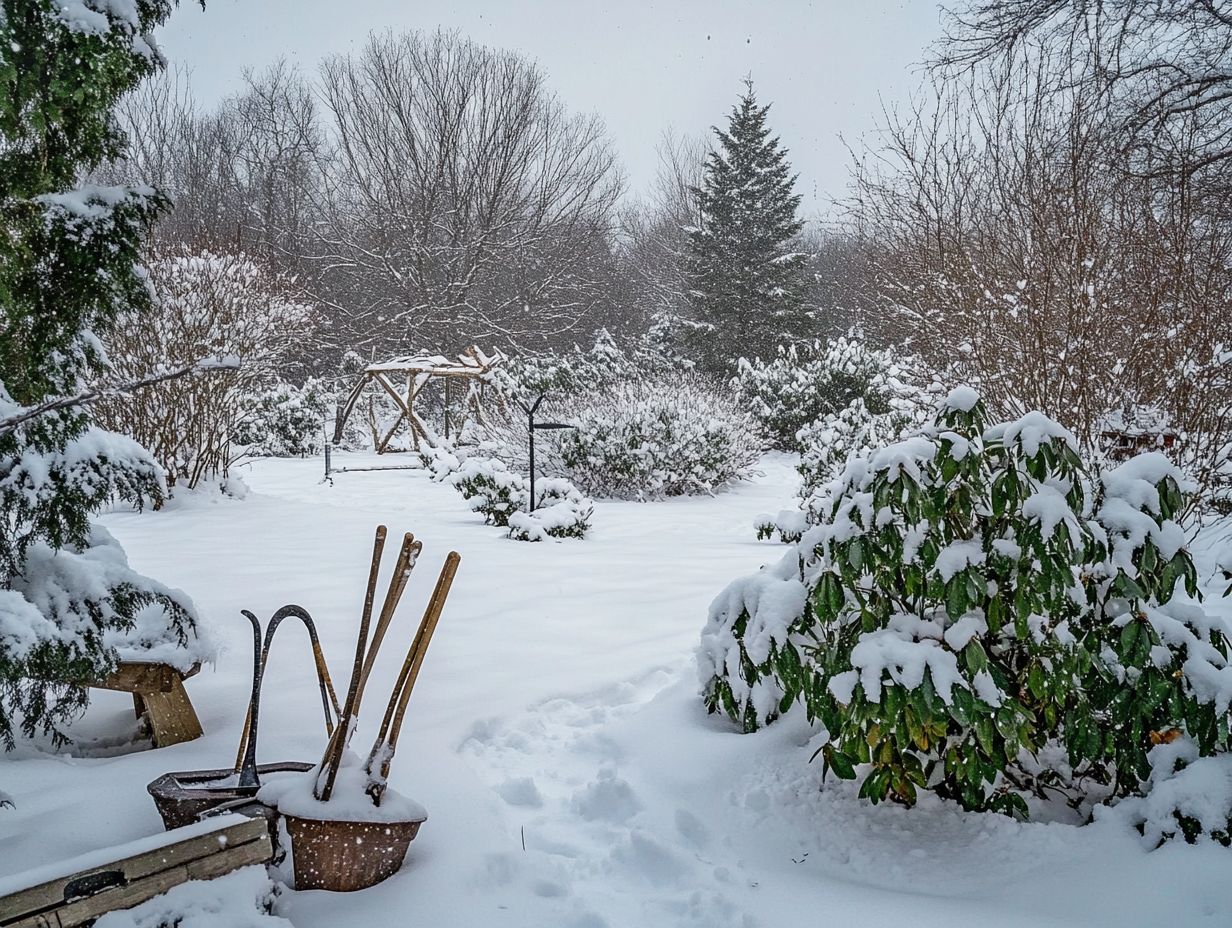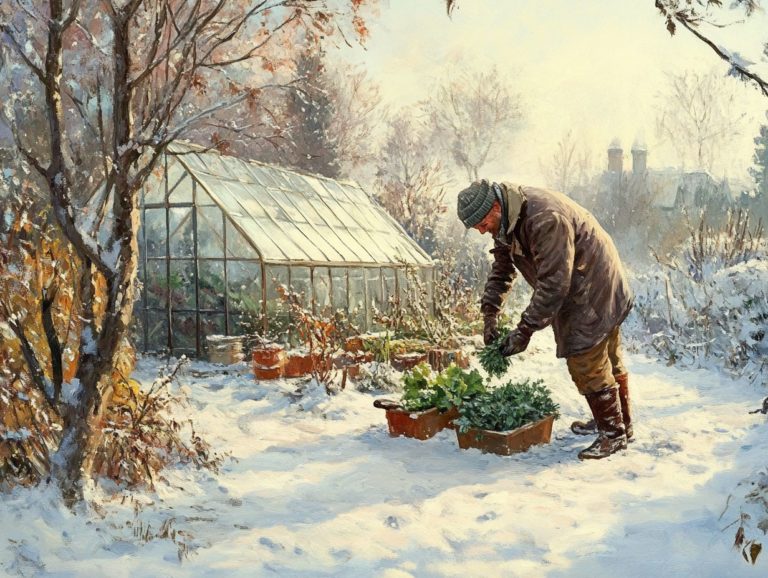The Role of Snow in Cold-Climate Gardening
Gardening in cold climates or cold-weather gardening often presents unique challenges, yet snow can play a pivotal role in enhancing plant health and resilience.
Think of snow as a natural insulator, safeguarding your plants from the harsh bite of frost! It can truly be your ally in the garden.
This article delves into the influence of snow on plant growth, offering effective winter gardening techniques and innovative strategies to leverage snow within your gardening plan.
You ll discover the benefits of snowmelt and learn how to manage it effectively to cultivate a thriving vegetable garden.
Whether you re a seasoned gardener or just beginning your journey, grasping the significance of snow can significantly elevate your winter gardening approach.
Contents
- Key Takeaways:
- The Importance of Snow in Cold-Climate Gardening
- Preparing Your Garden for Snow
- Using Snow as a Natural Insulator
- Harvesting Snow for Gardening
- Snow Melt: Benefits and Challenges
- Frequently Asked Questions
- What is the role of snow in winter gardening?
- How does snow protect plants in cold-weather gardening?
- Can snow be harmful to plants in cold-weather gardening?
- How does snow provide moisture to the soil in winter gardening?
- Are there any plants that benefit from snow cover in winter gardening?
- Can I use snow as a substitute for watering plants in winter gardening?
Key Takeaways:

- Snow plays a crucial role in cold-climate gardening, providing insulation, moisture, and protection for plants during winter months.
- Winterizing techniques, such as adding mulch and creating snow barriers, can help prepare your garden for heavy snowfall and extreme temperatures.
- Storing snow can help your garden by providing a free source of water during dry periods and reducing the need for irrigation. However, managing excess snow melt can also pose challenges for gardens.
The Importance of Snow in Cold-Climate Gardening
In cold-climate gardening, snow serves as a vital ally, offering insulation and safeguarding plants during their dormancy period. Understanding the key principles of cold-climate gardening is important for each plant and the overall garden health.
Winter gardening is becoming more important due to climate change. Understanding the role of snow in enhancing soil moisture retention, boosting nitrogen levels, and supporting the health of organic gardening systems also involves recognizing the challenges of cold-climate gardening to help you grow healthy gardens year-round.
How Snow Affects Plant Growth
Snow plays a pivotal role in plant growth by acting as a natural insulator, stabilizing soil temperatures, and safeguarding winter crops like carrots, spinach, and kale from harsh frost conditions. Understanding the role of soil in plant health in cold climates is also crucial for successful gardening in these conditions.
This insulation layer creates a distinct small, warm area that cultivates optimal conditions for these cold-hardy crops. Beneath the snow’s protective blanket, soil moisture remains intact, and microbial activity flourishes.
As a result, the plants can endure colder temperatures while still tapping into the nutrients necessary for developing robust root systems. In such environments, these crops don t just survive; they thrive, showcasing resilience and elevating their flavor profiles.
Thus, the interplay between snow and soil is vital for supporting diverse plant growth, especially during the frigid months.
Preparing Your Garden for Snow
Preparing your garden for the snowy season requires a thoughtful approach, employing a range of winter gardening techniques. By utilizing cold frames, row covers, and strategic mulching, you can effectively shield your plants from harsh weather conditions.
This prudent preparation not only protects your greenery but also sets the stage for maximizing yields of fresh produce come springtime! Get ready to maximize your garden yields!
Winterizing Techniques

Getting your garden ready for winter with techniques like cold frames and row covers can provide essential frost protection during the colder months, ensuring their vitality until spring.
By embracing these strategies, you can create a more favorable small, warm area around your plants, effectively shielding them from harsh winds and extreme temperatures. Cold frames function like mini-greenhouses, capturing warmth while allowing sunlight to filter through an essential ingredient for photosynthesis, even in winter.
To make the most of their benefits, position these structures in sunny areas and secure them against strong winds. Meanwhile, row covers act as lightweight covers, protecting delicate seedlings from frost while still permitting moisture and air circulation.
When implemented correctly, these methods not only guard against the elements but also encourage earlier harvests, making winterization a critical aspect of your gardening journey.
Using Snow as a Natural Insulator
Utilizing snow as a natural insulator is an exceptional gardening technique that not only shields your cold-hardy crops from frost but also helps preserve soil moisture levels throughout the winter months. Embracing this method is one reason to consider cold-climate gardening, as it can significantly enhance your gardening success during the colder season.
Protecting Plants from Frost and Cold Temperatures
Protecting your plants from frost and cold temperatures is essential in winter gardening. This ensures tender varieties survive. You ll maximize fresh produce in spring.
You can employ several effective strategies to shield your plants from the harsh winter weather. One tried-and-true method is using frost cloths or blankets; these can trap heat and create a mini-greenhouse effect around your vulnerable plants during the night.
Mulching around the base of your plants is another smart move. This helps insulate the roots, keeping them warmer and reducing those pesky freeze-thaw cycles in the soil. Elevating pots off cold surfaces and placing them in sheltered locations adds another layer of protection.
Understanding your local climate patterns will further give you the power to time these protective measures just right, ensuring your garden thrives even in the colder months.
Harvesting Snow for Gardening
Harvesting snow for gardening presents a helpful method for you, enabling you to collect and store snow for future use. This practice boosts soil moisture and keeps your crops cozy through the winter, ensuring they thrive even in the coldest months.
Collecting and Storing Snow for Later Use

Collecting and storing snow for later use can significantly enhance moisture retention in your garden, transforming it into a valuable resource for winter gardeners like you.
By employing efficient techniques, such as using hoop houses or mini hoop houses, you can maximize the benefits of this natural winter phenomenon. One effective approach is to create dedicated collection areas perhaps using tarps or containers where you can gather snow while keeping it free from dirt and debris. It s wise to position these areas away from high-traffic spots to maintain their cleanliness.
Once collected, store the snow in a shaded location to prevent it from melting too quickly, allowing you to utilize it gradually as needed. This technique boosts soil moisture retention and acts as a slow-release water source, nourishing your plants during the drier months ahead.
Snow Melt: Benefits and Challenges
Snow melt offers a unique blend of advantages and obstacles for you as a gardener. On one hand, it delivers the vital moisture necessary for the health of your plants. On the other hand, if not managed thoughtfully, it can complicate your spring gardening endeavors, requiring careful attention to detail.
How Snow Melt Can Benefit Plants
Snow melt can be a remarkable ally for your plants, offering a slow and steady source of moisture that’s particularly beneficial for soil health and the growth of early spring crops.
This gradual release of water not only helps prevent erosion but also maintains nutrient levels in the soil, creating an ideal environment for root development. As the snow melts, it enriches the soil with essential minerals, fostering healthy growth across a diverse range of crops from budding vegetables to vibrant flowering perennials.
With snow melt, your plants get the hydration they urgently need for a successful spring. This consistent hydration ensures that both gardeners and farmers can savor a robust and productive growing season.
Managing Excess Snow Melt in the Garden
Managing excess snow melt in your garden is essential to prevent waterlogging. This ensures optimal conditions for protecting and nurturing your plants as spring approaches.
To achieve this, you can implement several effective strategies that enhance the way water moves through the soil and safeguard your botanical investments. For starters, consider creating raised beds. This simple adjustment can significantly improve drainage, allowing excess water to flow away from the root zones.
Incorporating organic matter, like compost, into your soil enhances its structure, promoting better water absorption and aeration. Using mulch is also beneficial; it retains moisture and helps regulate soil temperature, providing your plants with a stable environment as they awaken from dormancy.
Adopting these techniques will help you cultivate a vibrant garden that thrives in spring!
Frequently Asked Questions

What is the role of snow in winter gardening?
Snow plays a crucial role in cold-weather gardening, acting as a natural insulator that protects plants from freezing temperatures and provides moisture to the soil. Additionally, understanding the role of soil in sustainable cold-climate gardening can enhance your gardening efforts.
How does snow protect plants in cold-weather gardening?
Snow creates a layer of insulation on top of the soil, helping to regulate temperature and preventing the soil from freezing too deeply. This protects the roots of plants from damage and allows them to survive through winter. To enhance your gardening experience, consider exploring what tools are essential for cold-climate gardening.
Can snow be harmful to plants in cold-weather gardening?
Yes, heavy snowfall can be harmful to plants in cold-climate gardening. Excess snow can weigh down branches, causing them to break, or create compacted snow that suffocates and damages plants. It’s important to remove excess snow from plants to prevent damage.
How does snow provide moisture to the soil in winter gardening?
When snow melts, it slowly releases moisture into the soil, providing much-needed hydration to plants during winter months. This moisture is essential for plant growth and survival, as the ground can often be too frozen and dry for plants to absorb water.
Are there any plants that benefit from snow cover in winter gardening?
Yes, many plants actually require a period of cold weather and snow cover to thrive. These include cold-hardy vegetables like kale and Brussels sprouts, as well as perennials like peonies and irises.
Can I use snow as a substitute for watering plants in winter gardening?
No, snow should not be used as a substitute for watering plants in cold-climate gardening. While it provides moisture to the soil, it may not be enough to sustain plants in winter. You should still water plants as needed, especially during dry spells.
Start preparing your garden today for a thriving spring!






